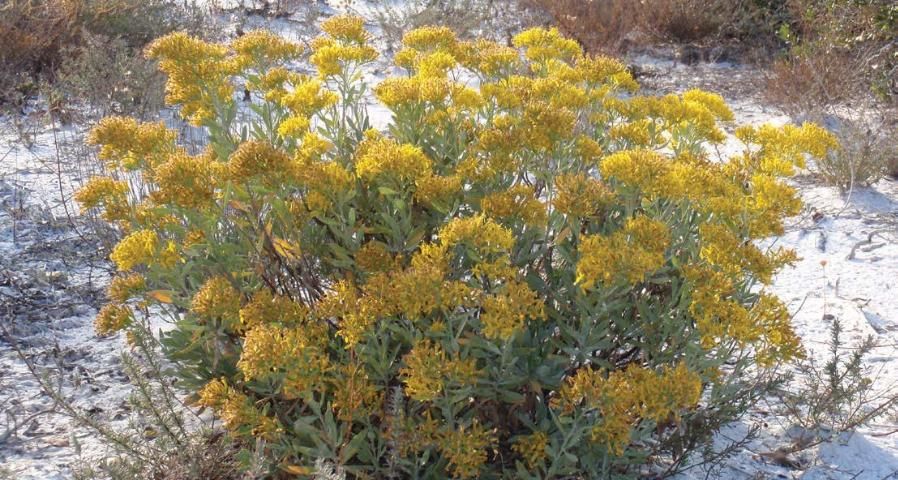Note: This fact sheet is also available as a chapter in a comprehensive manual titled Dune Restoration and Enhancement for the Florida Panhandle, available in pdf form here: https://edis.ifas.ufl.edu/pdffiles/SG/SG15600.pdf. Please see the manual for more information about other useful and attractive native plants for dunes and for further information about restoration and preservation techniques.
Asteraceae

Credit: Mack Thetford, UF/IFAS
Woody goldenrod is found in beach dunes, scrub, and sandhill plant communities. It occurs in the Panhandle of Florida and more broadly in the southeastern United States west to Mississippi and northeast to North Carolina. This plant may leach chemicals into the soil that inhibit seed germination of gulf bluestem (Schizachyrium scoparium var. scoparium) (Fischer et al. 1994). Woody goldenrod is an underused landscape plant with a prolific fall color from flowers that attract numerous pollinators.
General Description
Woody goldenrod is a multibranched, evergreen sub-shrub that can reach heights of 3.3 ft or more. Stems are glabrous, numerous, ascending, and round in cross section. Stems bearing flowers and fruits extend far beyond vegetative stems. Leaves are sessile (without stalks), simple, 0.75 to 2.5 in long, alternate, elliptic to oblong, and grayish green with an entire margin. Inflorescences are heads that are sticky, borne in clusters, and numerous, with a single outer row of yellow ray florets. They occur from late summer to fall. Fruits are hard, dry, pale, bristled achenes.
Propagation
Cutting propagation of woody goldenrod is easily accomplished with terminal stem cuttings. Nonbranched, vegetative apical stem cuttings from summer softwood or winter hardwood root without auxin, but a 5,000 ppm IBA (Indole-3-butyric acid) application will increase root numbers and root length (Wilson et al. 2010). Propagation from seed for woody goldenrod has been accomplished with wild-collected seed. Seeds prefer cooler temperatures (20/10°C alternating day/night temperatures) to warmer ones (Wilson et al. 2010).
Outplanting
Rooted cuttings or seedlings may be grown in a variety of coarse production substrates and a variety of container sizes. Smith et al. (2014) produced woody goldenrod in substrates such as Atlas 3000, Atlas 7000, Fafard 3B, and Metro Mix 300 while the authors have grown them in a 100% pine-bark substrate amended with lime and slow-release fertilizer. Plants grown in 1-gal containers were evaluated for potential use in home landscapes with high transplant success (Smith et al. 2014). Peak flowering for the trial plants occurred in November.
Literature Cited
Fischer, N.H., G.B. Williamson, J.D. Weidenhamer, and D.R. Richardson. 1994. "In search of allelopathy in the Florida scrub: the role of terpenoids." Journal of Chemical Ecology 20(6)1355–1380.
Smith, A.M., S.B. Wilson, M. Thetford, K.L. Nolan, and C. Reinhardt Adams. 2014. "Performance of nine Florida native wildflower species grown in varying container substrates." Native Plants Journal 15(1):75–86.
Wilson, S.B., H. Perez, and M. Thetford. 2010. "Propagation, Production, and Landscape Evaluation of Native Wildflowers in West, Central and South Florida, 2010 Condensed Progress Report." https://www.flawildflowers.org/wp-content/resources/pdfs/Research/Wildflower%20year-end%20progress%20report-Wilson%20et%20al.pdf